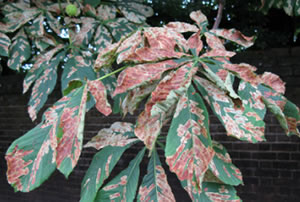Save Horse Chestnut Trees By Burning Autumn Leaves
A plea for a change in leaf burning rules to combat Leaf Liner moth damage
|
It is rather a sad sight, seeing our poor Horse Chestnut trees going into
what appears to be an early autumn. Maybe you know what is causing this,
but if you don’t let me tell you.
There is a moth that has spread its way across Europe in the last 10 year
or more and is infecting our trees causing this early browning.
It has gained a foothold because of the change of practice from burning
leaves in the autumn.

A
n image of a horse chestnut tree affected by Leaf
Miner Moth
If the leaves are burnt, the life cycle of the insect
is broken and the next year the tree will be less affected, until finally
if the leaves are burnt every year, it could probably be eradicated.
Unfortunately, Councils have changed the rules on garden fires and burning
of leaves from our street trees. Composting them instead does not destroy
the moth larvae, so the next year the moths hatch and re-infect the trees.
If we could change this policy and return to burning all the leaves we
could save the Horse chestnut trees. At present, the trees are losing
2-3 months of the summer when they can make food in their leaves and give
them the nutrition they need to survive. The way we are going, the trees
will be seriously weakened and will die sooner than they should.
The problem is now countrywide, so we are facing the prospect of losing
this whole species of tree. The Sweet chestnuts do not seem to be affected
as they are a different species.
We do have in Chiswick – in the Cambridge Road North area - a few Asian
Horse chestnuts trees. They have been propagated from a tree just near
the main gate inside Kew Gardens – easily grown from one of the conkers.
They are similar to our familiar Horse Chestnut trees, but flower slightly
later, which is good for pollinators as it extends the season of their
food supply, and the conkers have beautiful markings on them. But I have
not yet found out if they are also susceptible to the Chestnut tree moth.
So there is a solution if we have the will to tackle the problem, and
if Councils will reverse their policy of not allowing leaves to be burnt.
I mentioned Kew gardens, which has not escaped this problem. It too has
infected Horse chestnut trees. Might it be possible for the management
of Kew Gardens to spearhead a recovery programme and save out trees?
Annette Duckworth
September 16, 2017